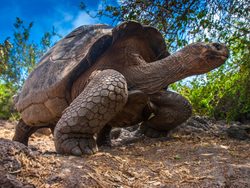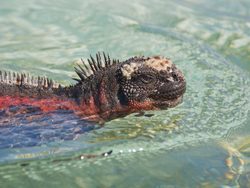
Galapagos National Park
Quick Navigation
Galapagos National Park is located about 500 miles (926 km) west of Ecuador, the islands are part of the country. The national park is home to the Galapagos Islands with the park boundaries encompassing an area of 3,040 square miles (7,880 sq km).
There is a total of 21 islands with 18 of them considered significant. The total Galapagos Islands measures square miles (7,995.4 sq km) and spread across 17,000 square miles (45,000 sq km) of ocean waters. Galapagos National Park is a UNESCO World Heritage Site and the country’s first national park.
The highest point in the Galapagos Islands occurs at Volcán Wolf on Isabela Island and it reaches a height of 5,600 feet (1,707 m). Isabela Island is the largest island and accounts for the majority of land area in the Galapagos. The Ecuadorian government has declared 97% of the Galapagos Island area as a protected area through the Galapagos National Park.
Along with Isabela, Baltra, Floreana, San Cristobal, and Santa Cruz are the populated islands and account for about 3% of the total Galapagos Island area.
The wildlife in the Galapagos Islands is globally renowned featuring the Galapagos land iguanas, the marine iguanas, and the giant Galapagos tortoise. The marine iguanas of the national park are the only ones that swim and eat from the sea.
Other popular species include the green turtle, blue-footed booby, waved albatross, and the Galapagos hawk and Galapagos penguin. Sea lions, whale sharks, hammerhead sharks, and several other marine species await divers and snorkelers.
Endemic mockingbirds, finches, and tanagers are special treats for visitors as well.
Highlights
The highlight of the Galapagos National Park is the Giant Tortoise, the marine iguanas, the blue-footed booby, and the colorful crabs. Along with the endemic species and abundant marine life beneath the sea, the wildlife is the draw and highlight of the islands.
 Giant Tortoise
Giant Tortoise
The Giant Tortoise is the largest living tortoise in the world and is only found on the Galapagos Islands. They can reach lengths up to four feet (1.22 m) and weigh as much as 400 pounds (181 kg). A second species is known as the Aldabra giant tortoise and is located in the tropical islands of the Aldabra Atoll in Seychelles.
The giant tortoise typically lives over 100 years with some reaching 170 to 250 years old. There are 10 species of giant tortoises found within Ecuador's national park. There are two key characteristics present on the tortoises depending on their habitat. Those that are on islands with more rain have a saddle-backed presentation. The domed tortoises are bigger with shorter necks and legs.
Without question, these magnificent creatures are one of the highlight encounters with nature available on the Galapagos Islands.
 Marine Iguana
Marine Iguana
The marine iguana is also called the sea iguana, the saltwater iguana, and the Galapagos Marine Iguana. It is a unique species, endemic to the Galapagos Islands, and they are only found here. There are eight different subspecies that have been identified amongst the hundreds of them in the islands.
The marine iguanas can reach lengths of 22 inches (56 cm) with the tail adding as much as 33 inches (84 cm). They range from 4.7 inches (12 cm) up to upper limits. The adult male may weigh as little as 2.2 lbs (1 kg) up to 26 lbs (12 kg). The males usually weigh about twice as much as the females.
They typically live in colonies ranging from as little as 20 up to larger colonies of around 500. In rare cases, a colony may increase to around 1,000 members. Witnessing these striking creatures swimming in the ocean waters is a highlight and unique experience not seen anywhere else in the world.
Galapagos National Park Trails
There are several different trails and hikes available across the different islands. Here is a look at some of the most popular.
Park Protection
Galapagos Islands National Park was created to protect the unique endemic wildlife species that live amongst the islands and ocean waters around the islands. The protected area also invests in the historical scientific observations by Charles Darwin that gave us insights into understanding the animal kingdom.
The national park protects the globally renowned endemic species that seem to appear nowhere else in the world. It is imperative that the global community do everything possible to help support and protect these island habitats and their incredible display of nature.
Galapagos Highlights
- Giant tortoise
- Marine iguana
- Galapagos land iguana
- Diving
Park Map
Sources
- Britannica, Galapagos Islands, https://www.britannica.com/place/Galapagos-Islands, retrieved September 2019.
- Galapagos Conservancy, Galapagos National Park Rules, https://www.galapagos.org/travel/travel/park-rules/, retrieved September 2019.
- Lonely Planet, Galapagos Islands, https://www.lonelyplanet.com/ecuador/the-galapagos-islands, retrieved September 2019.
- National Geographic, Galapagos Islands, https://www.nationalgeographic.com/travel/world-heritage/galapagos-islands/, retrieved September 2019.
- Parque Nacional Galapagos, National Park, https://www.galapagos.gob.ec/en/national-park/, retrieved September 2019.
- UNESCO, Galapagos Islands, https://whc.unesco.org/en/list/1/, retrieved September 2019.
- World Wildlife Fund, Giant Tortoise, https://www.worldwildlife.org/species/giant-tortoise, retrieved June 2020.























